I know all you can think about is the election. But you should probably take a break and get caught up on the best bike-related stories we came across last week…
Hales sees the light: Remember that no good, horrible, very bad decision Mayor Charlie Hales made in 2013 to enact parking minimums on new residential development? Now he wants to remove them.
Seattleites are over I-5: This article about removing I-5 through Seattle could be — should be! — written about Portland. That freeway sucks and has no business bisecting our central city.
More freeway removal: The city of Rochester in upstate New York filled in a central city freeway with dirt, “to focus on pedestrians and establish vital neighborhoods for housing, expanding businesses and producing jobs.”
As goes Los Angeles, so goes…: A ballot measure in Los Angeles would raise big money ($42 Billion) for light rail. The LA Times has a great rundown on that and a general overview of the non-driving transportation mix in the driving capital of America.
SoCal transit haters: To give you an idea of what L.A.’s transportation reformers are up against, check out these bus-hating Venice residents fought against a new bus route through their neighborhood and then celebrating victory with a tasteless piñata.
“Safe mobility” not “Vision Zero”: The California city of Santa Ana is not just boldly breaking from their County’s auto-centric policies, their new plan to eliminate traffic collisions is called “Safe Mobility” instead of the more popular and well-known “Vision Zero”.
Advertisement
Biking on main street: It’s simple: Backstreet and “neighborhood greenways” aren’t enough. If we want to be a real cycling city, we must make it safe and easy to bike on main commercial streets. But don’t take my word for it, check out the analysis by Michael Andersen.
The cost of car abuse: A new report has found that a whopping half of all injuries treated at a major hospital in San Francisco were from traffic collisions — and the cost to treat them was $105.5 million over two years.
An eye for an eye: China’s traffic enforcement is not messing around when it comes to cracking down on people whose bright lights blind other road users.
Cool bikes in Detroit: The Guardian has a fun photo essay of the creatively customized bikes that roll on the streets of Detroit.
Put that money into bike lanes: A study published in the journal Injury Prevention found that New York City’s bike lane investments have led to “exceptionally good value because they simultaneously address multiple public health problems.” The study went so far as to say that spending money on bike lanes to improve health is, “more cost-effective than the majority of preventive approaches used today.” Bloomberg News also covered the study.
Copenhagen tipping point: This line from Copenhagenize says it all: “For the first time since the City starting counting traffic entering the city centre, there are more bikes than cars.”
Is it really that complicated?: Not sure to smile or cry at the news that the state DOT in Colorado is having such a hard time preventing vulnerable users from being hit and killed on their roads they’re willing to pay the public for new ideas.
Drop us a line if you come across a great article and want us to consider sharing it in next week’s roundup.
— Jonathan Maus, (503) 706-8804 – jonathan@bikeportland.org
BikePortland is supported by the community (that means you!). Please become a subscriber or make a donation today.


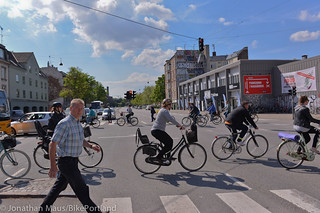
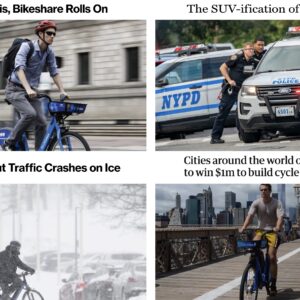
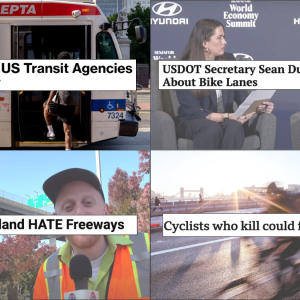
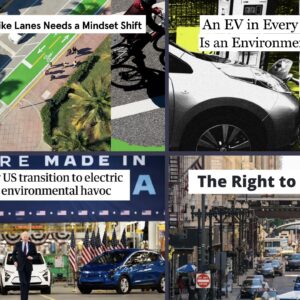
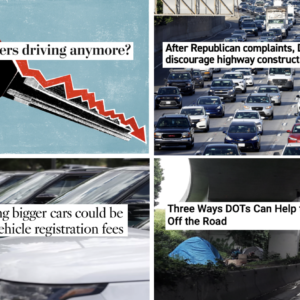
Thanks for reading.
BikePortland has served this community with independent community journalism since 2005. We rely on subscriptions from readers like you to survive. Your financial support is vital in keeping this valuable resource alive and well.
Please subscribe today to strengthen and expand our work.
Wow, that Rochester freeway that they are filling in had average daily traffic of only 6,000 vehicles before it was decommissioned. I’m guessing it would be a tougher sell here for I-405 given its traffic volume of 80K-128K depending on where you are.
I think we should keep the freeway and just tame it down to city speeds, particularly at the ramps so they don’t infect nearby streets. Push to get cars off of surface streets and make this the easiest way to get around in a car. Cleanup the flow and prevent backups from too-late merging (not to be confused with zipper merging) and other anti-social behavior. Maybe some jersey barriers in some places instead of solid stripes of paint. Setting the speed limit at 30mph would allow striping at least a couple more lanes to most parts. What do we gain by removing it if that just unleashes all of the traffic into the grid?
Major engineering and budgeting challenge, but covering I-405 could be a great benefit to the city, as would submerging the section of I-5 on the east side. Maybe it’s too late a stage in the city’s development of the west side waterfront to take on the latter…there’s that big gangly and dangerously tall bridge to deal with y’know.
I guess I’ve got to google Seattle’s project with the Alaskan Way tunnel. Since the tunnel machine hit rocks, I haven’t heard of much progress, for months.
Just the opposite actually – Once Seattle’s tunneling machine got through the fill and into rock it has been making steady progress, pausing only for scheduled maintenance. It’s something like 70% complete now.
Any alternative to truck freight traffic coming into an urban area needs to be as efficient as and no more expensive than current truck freight paradigms. Anything else will simply be swatted down by every business alliance and chamber of commerce everywhere.
Portland luckily has terrain constraints that keep it from being able to built out into a freeway wonderland like DFW but until a viable alternative, that can move the tonnage at a comparable price, can be deployed we will be stuck accommodating big trucks in some painful way.
Simply removing the 405 will not remove the pain; you have to eliminate the need for trucks. As long as human beings group into dense urban areas we will continue to need to get freight in and out of out our human scale communities.
article about removing I-5 through Seattle: https://www.theurbanist.org/2016/11/04/more-support-for-removing-i-5-downtown/
thanks Spiffy! I had the wrong link in there. fixed it now.
re. Bike infrastructure on arterial streets: This was a much larger focus of the previous PBOT Bicycle Master Plan than it is in the current plan. Just sayin’…
Great point about the lack of commercial corridors without cycling infrastructure. It still completely baffles me that Portland has only a handful of commercial streets with any cycling facilities. Even Chicago has door-zone lanes on most business stretches. Most Portland streets have absolutely nothing. It’s not as if there isn’t room: Burnside, Hawthorne, Grand, Belmont, and basically every downtown avenue have plenty of room for protected cycleways. It’s just that the city prioritizes getting cyclists out of the way of drivers, rather than actually promoting cycling as a form of every day transportation.
Agreed! Trying to go to a specific store on a busy street is an akward navigation of taking a neighborhood greenway to get you close then walking or biking on the sidewalk to get the last few blocks.
I wonder how many entries that Colorado prize competition will get saying, “Slow drives the f*** down.”
yeah I just don’t understand why, in 2016, this is considered some sort of mystery. The reality is that the DOT is simply unable to implement the known solutions because of fear and/or politics so they’re looking for something that is perhaps more palatable. sad
of course I meant “drivers” there.
Not many from anyone hoping to get some of the money offered. Indication is that CDOT is hoping for some ideas a bit more innovative than someone just venting frustration, annoyance, whatever, in an offensive way. With its competition, CDOT looks to be hoping to inspire people to imagine some innovative ideas that will be superior in effectiveness to existing infrastructure ideas.
The dept mentions ‘teams’, which leads me to expect its thinking in part about high paid engineers and designers of big companies, that CDOT would have to pay a ton of money, far more than 500,000, to get solid advice from.
To ordinary working people that amount of money sounds like a lot…and it is…though when it comes to actually installing infrastructure, it’s not a lot of money. Example: crosswalk signals cost approximately 250,000, apiece. So I’ve heard,could be mistaken.
Overspending is one of the big problems in the U.S. The competition may come up with some good ideas. Not necessarily a bad way to engage the public in being more conscious of their road infrastructure. Though it’s important at the same time, to think some about how CDOT is spending money in its budget for already known and proven effective bike and walk infrastructure,
My point, which was apparently lost in my use of naughty language, was that the very best thing they could do, they already know about. A million people could tell them for free. It doesn’t NEED to “innovative”. They’re looking too hard.
“…It doesn’t NEED to “innovative”. …” hawley
You speak with authority, as someone that knows something about Denver’s traffic congestion issues.
I can’t say that I do, and though I didn’t spend any time to day reading up on what those issues are and what means the city already has been using to deal with them…the impression I got from the story, is that the city may be using some of the bike and walk specific infrastructure ideas already, and still finds it needs some additional, innovative ideas.
The programs’ bike and pedestrian challenge, ‘RoadX rules and guidelines’ is worth a look, if you haven’t studied it already:
https://www.imagineco.us/en/page/roadx-rules-and-guidelines-en
From the limited reading I’ve done about it, I can’t see exactly why Denver is running this challenge, but until I hear more about the traffic issues the city is dealing with, I’m not going to dismiss the challenge idea outright.
Okay so you remove I-5 from precious inner Portland. So you just force more congestion and pollution on to us east side residents around I-205? Sounds about right.
While we’re all dreaming, let’s just stick most of it in a tunnel.
I hope you don’t just mean I-5. We probably should stick everything that motorized vehicles use in tunnels. I know it will be tough fitting the bridges in there, but it will all happen if we advocate strongly enough.
Yes because that is going so well for Seattle…
I don’t know specifically why the Seattle project is having so many problems. But I’ve seen some spectacular infrastructure in Asia, and I think we could find a way to put more high throughput roadways underground.
Boston’s Big Dig may have its critics, but it was also the first of this kind of project and literally broke new ground. Burying highways doesn’t make traffic go away, but it does create greenspace above it, and allow for more manageable cross-town routes, especially for peds and cyclists. While the tunnel still has problems to this day (like random ceiling tiles impaling passing cars), I shudder to think of what would have become of the city had they not buried its main artery.
I can think of lots of other things I’d rather have the city and state spend $14.6 billion and 25 years on. It would be cheaper just to tear the thing down for good and it would create wealth along the east waterfront.
Except that kind of money will continue to be spent on maintaining highways, regardless of whether they’re underground, elevated, or directly cutting cities (like SF) in half.
(Van Ness is Highway 101, to clear up my reference).
http://www.dot.ca.gov/d4/newsreleases/van-ness-improvement-project-brief-newsletter-april-2016.pdf
A couple years ago, I saw a show on PBS about Boston’s big dig. That’s where about the entirety of my knowledge on that project comes from. The reporting on the show said basically, that the project was hugely expensive, and fraught with serious engineering problems. There seemed to be considerable question that the infrastructure would ever be viable for use. Don’t know what the status is now.
Despite detailing of the problems, it remained clear that it was essential for Boston to have the tunnel in order to deal with the effects of heavy motor vehicle use on the city. Somewhat related, that’s why Seattle has to have the tunnel its building, and Portland eventually will have to do something to reclaim the east-side waterfront land that I-5 occupies, by handling the traffic using it, another way.
Tear out the Marquam and I-5 on the east bank. Turn half of the land into a park, and sell the other half to private developers. Use that money to add a lane to I-405 and lid as much of it as possible.
The Marquam…that’s the bridge whose name I was trying to remember yesterday. That thing is dangerous. Kiss it and everyone on it goodbye, when the big shake comes. Maybe people should start carrying parachutes in their cars.
It’s ugly and dangerous, and together with I-5 on the east side near the waterfront, kind of ruins that important area of land within the city. Are there no better ideas for handling the traffic this infrastructure carries, than to just tell the people driving on it to go away? I hope someone is giving some serious thought as to what can be engineered to provide for the travel needs of people using this bridge and that section of freeway.
Use I-405 or I-205. We would want to replace the Marquam with a bridge similar to the Tillicum, connecting Water just north of OMSI to SW River Pkwy. 2 general purpose lanes, 2 streetcar/bus, and wide sidewalks.
To be clear, I didn’t mean my comment about “while we’re dreaming” to sound as rude as I think it does upon a re-read. I’m sorry about that.
I don’t think I would support a proposal to diver I5 in such a way, but I recognize fully there are always two sides when a road bisects a city.
Fair enough.
Not necessarily Lester.
A lot of the traffic would disappear. Many of those I-5 trips are made because a car is unfortunately the fastest vehicle depending on where you’re going. Take out the freeway and biking and transit would compete much better and therefore more people would do it.
You should not always assume the given level of traffic is a constant. Traffic is the byproduct of a culture and a system that promotes auto use at every level…. If we promote something else, people will make different choices.
Detroit bike pictorial was a fantastic way to light up a Monday – thanks!
Michael’s article on bike facilities on business corridors makes me feel old. He quotes another post that contains the following, “Historically, North American cities have placed their bike routes on side streets rather than main streets…” As I recall, when Davis, CA started putting in a few bike lanes it was the first city in the nation to do so, making that kind of important in terms of history. The bulk of the bike lanes were precisely on business corridors (3rd St, F St, L St Covell Blvd, Anderson Rd) as well as streets with schools.
I guess if one thinks the history of bike use started with this century, then such a quote is accurate. Unfortunately, that would miss an awful lot of things like the largest bike boom in history (or is that pre-history now?).
I wish we had great cycling infrastructure on arterials like Hawthorne, Burnside, Belmont, etc.
But if we’re just going to get some door-zone bike lanes (like SW Broadway, or SE Sandy) then I’d rather just spend that money on our greenways. The greenways aren’t perfect, but I don’t think I’ve ridden a single bike lane in Portland that’s lower stress than a typical greenway already, and they could be *massively* improved with some imagination: we could expand the diverters from an ad-hoc setup in locations with too many vehicles to a systematic approach that removes through-traffic from greenways entirely, and maybe borrow the 5mph speed limit from Barcelona’s superblocks as well.
It’s not perfect, but:
– people who want to cut through the greenways to save commute time don’t have any political clout, people who complain about traffic on arterials do
– people who live on greenways will be happy to reduce traffic volumes outside their front doors–so this has the potential to gain support outside of the active transportation community
– much cheaper than reengineering big streets and no issues with highways being owned by less bike/ped friendly agencies
– while I don’t get to bike *along* the commercial blvd to my destination, Portland’s grid means that I can generally get very, very close using bike boulevards and even closer (<1 block) using other neighborhood streets. The neighborhood greenway network offers perfectly acceptable routes for the short non-work trips described in the article.
What if I don’t know exactly what block my destination is on? I often don’t memorize intersections – when I know what place I am going to, I often just keep riding on the street it’s on until I see it.
What if I simply want to cruise around a shopping district and stop into stores that look good? What if I’m hungry and don’t know what I want to eat? These are part of the joys of living in a city – simply browsing and wandering without a set destination in mind.
People driving and walking get this opportunity, and so should people cycling.
My cold dark heart likes China’s solution to high-beam drivers (forcing them to stare into high beams for a minute). It reminds me of one of the many worlds tasted in Heinlein’s book The Number of the Beast. On that world, the justice system was strict eye for an eye. The travellers chanced upon a convicted careless driver being subjected to his punishment. As the ambulance crew stood by with a stop-watch, a car was driven over the guilty party. After the same wait as his victim had endured, the ambulance crew hopped into action to try to save his leg.
Imagine how people would drive if they were subjected to the same treatment as their victims? Needless to say, we’d be down one habitual unlicensed driver and one person who likes to use left turn lanes to speed past other cars.
Perhaps we can make our streets safe by less barbaric means, but I’m beginning to doubt it.
I like it. The penalty for speeding would to be tied in the middle of the road and rammed with a car going as fast as the difference between the legal speed and the speed the scoflaw was convicted of. Gotta Love Heinlein.
Motorists would quickly grok cycling with just a few scary right hooks.
The penalty for right hooking a cyclist would be to be put in the ring with Mike Tyson ( or modern equivalent) and get a few right hooks for each infraction.
The day that portland rips out 405, is the day it will truly become a great city.